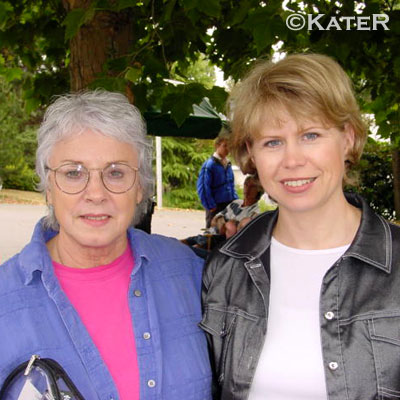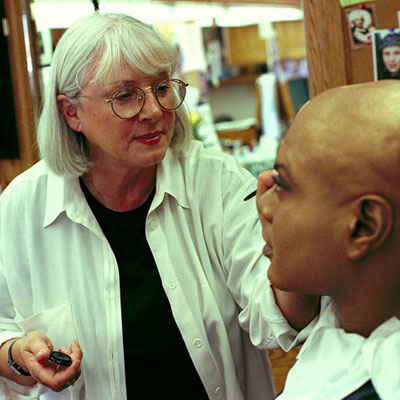BEAUTY AND BEAST
An Interview with Stargate's Make-Up Artist, Jan Newman
Your average television show might have a handful of stars and guest cast who need a touch of powder and a hint of color to look good for the camera each week. But Stargate SG-1 is far from average, and the art of make-up in the world of science fiction requires creativity and imagination as much as it requires talent and technique. Providing the look for humans and aliens alike in the Stargate universe is Jan Newman, a gentle, soft-spoken woman with a quick smile and a twinkle in her eye. As the Key Make-Up Artist, Jan heads the Make-Up Department and oversees the application of make-up and the development of new designs for both exotic beauties and bizarre beasts.


Jan Newman and her assistant, Dorothee Deichmann (left), and Jan applies the trademark eye shadow to Teal'c (right)
Jan Newman has had a varied background, with experience as both a nurse and an airline flight attendant. She learned the art of make-up later in her career, after having settled in Canada from her native Australia. Her early training was in the theater, but she has worked in television make-up for many years, including four years with Richard Dean Anderson's previous series, MacGyver. Now on Stargate she finds herself, in many respects, pioneering techniques that the unique world of science fiction demands.
Each week, a new episode is being prepped while the current episode is being filmed, and Jan typically finds herself working on both production and pre-production simultaneously. Pre-production begins with a series of meetings that help to outline the special requirements of an episode. "I usually try to go to a concept meeting or a production meeting," Jan explains. "A concept meeting is the very beginning of our prep, and gives me an idea of what they want, and what I can contribute, and that allows questions to come up that I can ask later on. Then we get revisions on the script, and I can break down my script once the assistant director's given me his schedule. Then for any questions I have after that, there usually is a private meeting with the director and the producers. And then we go into what we call 'show-and-tell.' If I have to do a prosthetic piece, I show them what it is, what it's going to end up looking like, and then I can know what my step will be on the day of shooting. In this particular situation, we're preparing some bullet wounds and some shrapnel wounds," she says, referring to the episode currently in pre-production. "And I'm going off now to meet the prosthetics maker.
"I don't specifically design anything in particular for prosthetics," she continues. "I supervise the entire make-up department, and my job is to make sure everything goes smoothly. It's always a collaboration, and hardly anything we do on any show is individual." For example, in an episode like One False Step, the Make-Up and Costume Departments coordinated closely to design the look for the humanoid aliens, to be certain that the artists could recreate the design. "One False Step we designed along with the Costume Designer. When we had our meeting, we designed the make-up lines to join up with lines on the costumes. In that case they were all bald, so we didn't have to put bald caps on them. They allowed us to shave their heads, so that was great. There's a line between straight make-up and prosthetic make-up, but when straight make-up involves things like facial designs, then along with the Costume Department and the Art Department, we decide what we're going to do. We do a show-and-tell, we take photographs, so that the make-up artists coming in will know exactly what they're going to be doing."
For an episode like Metamorphosis, which involved extensive prosthetic designs, Jan coordinated with a team of prosthetic artists. "They usually have a lot of stock things, but when it gets to be a really big prosthetic, then we have a designer in Los Angeles named Todd Masters." It was Todd who created the designs for the badly deformed victims of Nirrti's genetic experiments, and a team of four or five prosthetic make-up artists worked on bringing the designs to life, but Jan remained involved in the entire process. "It's a little different when you're designing make-up for, say, prosthetics. A lot of designers will design and then give the designs to people to execute. That doesn't happen on this show. It's not necessary on a show like this." On a smaller scale, a frequently used prosthetic piece is the staff weapon wound, created in collaboration with the Special Effects team, "because this involves flames and things like that," she explains. "We actually burned this stuff, and then we took it out and we dried it, and it worked! It's a product we make bald caps out of, so it's a plastic resin that we light on fire, and it bubbles and blisters. It's good stuff!" she laughs. "We have quite a stock of them now. Over the years we've accumulated quite a few."
Each of these designs, and the specific make-up used on each character, must be meticulously documented. Many characters return in later episodes, or second unit scenes may need to be re-shot at a later date, and it is vital that all the shots of a given character match. Another part of Jan's job is keeping the exhaustive notes that are regularly used for reference. Episodes like Smoke & Mirrors, which are less demanding from a make-up perspective, provide an opportunity to keep the records updated. "Episodes like these are good. I call them housekeeping episodes," she smiles. "They allow us to get caught up on other things. We have got an archive of all of the shows, everything we've done from the very first episode. So it gives us a chance to get caught up on all our notes and put everything in the proper perspective for times when we have to go back to an episode where a character has been on before. Then it's quick for us to go back and pull the pictures and our make-up notes."
These notes become a crucial guide, especially when scenes are shot later to be inserted into an earlier episode. These "inserts," such as close-ups of faces or hands, are often shot days later by a second unit, and must match the original footage. In this sense, Jan often finds herself coordinating post-production work as well as filming and prepping. "In some ways we are doing post-production, because we will go back and we'll do second unit work from two or three episodes. Just before we had our break, we did pieces of five different episodes in one day. So you really have to keep all those notes, and that's why our archives are really up to date. Everything goes in there so that if I'm not around, somebody else can go to it, pick it up, look at the pictures, and have all the notes. It's the same with the Costume Department. If they don't have those notes, they can't match things. It's a very, very important part of the job. You sort of roll into that sort of thing. That's why somebody with less experience would be a bit frazzled by it. But I'm lucky, I'm old enough to have experience!" she laughs.
Of her many responsibilities, it is the personal interaction she enjoys the most. "I think my preference is the hands-on, working closely with the actors. I'm not a prosthetics make-up artist at all. I mean, I do small effects, but it's not my background. It's a little bit laborious, and tedious, and it's very labor intensive. So it's easier for me to just keep track of everything that's going on," she adds, but it is working directly with the actors in the application of the make-up that she prefers. Once again, there is a cooperation of departments. In some countries, including the United States, the Make-Up Department includes both make-up and hair. In Canada, however, the two departments are separate, and Jan works closely with Patrick O'Brien, the Key Hair Stylist, to prepare each of the actors. She also relies on her assistant, Dorothee Deichmann, to look after the actors on the set when her attention is needed elsewhere. "I'm responsible for the principal actors, and my assistant looks after the secondary, or day players." Often they share responsibilities when a shooting schedule, such as the one earlier in the day, requires the presence of both O'Neill and Carter. "When I was getting Richard ready, she was looking after Amanda. She's a great girl," Jan says of her assistant. "I'm very very lucky. I've had wonderful assistants in the years I've been working on the show."
Her years on the show have also enabled her to experiment with various techniques. The tattoo created for Teal'c, for example, originally involved an application process of nearly an hour, making for some very early mornings for both Jan and Christopher Judge. However, the process has been streamlined over the years, and Jan smiles as she speaks of her morning sessions with Christopher. "We just have such a great time when he comes in. It used to be very difficult to get him to even be on time, but now he's perfect. He's never late, and he sits in the chair. Because we've created this one-piece tattoo, we managed to reduce Christopher's make-up to a much more manageable 20 or 25 minutes. This has been really good for the show, to be able to schedule things, so it's much more manageable for everybody in the morning."
As the key make-up artist during the four years that MacGyver spent in Vancouver, Jan Newman's relationship with Richard Dean Anderson goes back more than 15 years. "I've been with Richard since the MacGyver days, so that was part of my role, to make sure that everything goes well for him," she smiles. That includes knowing him well enough to anticipate and circumvent any problems that might arise. With the busy schedule of actor and executive producer, and a reputation for nervous energy, Richard prefers to spend as little time in the make-up chair as possible. When a script calls for special make-up for O'Neill, Jan tries to simplify the task. During the pre-production meetings for Paradise Lost, the producers discussed the possibility of a fake stubble beard and a serious leg wound for the stranded O'Neill, but Jan discouraged the idea of a beard, knowing the extra time involved, and suggested that a prosthetic wound or a photo double might simplify the scene. With a smile of patience mixed with fondness, she explains, "You know, Richard is so amenable to almost anything, but he doesn't like to sit still very long. So to get him into the make-up chair is a big effort, and to have him sit still. For a prosthetic, I think the longest he's sat was when we did the episode where he was aging. He was brilliant. He was absolutely marvelous. He sat still and he did it because he really wanted to create that look. But generally he's pretty impatient for things like that," she adds with a wink.
Her fondness extends to the entire cast and crew as she looks back on the people who have made the long hours such a pleasure during her many years with the show. "It's such a delightful cast. You know, it truly does sound common, but I just love coming to work. When we get really tired, it's a bit fatiguing, but it's a great show, and a wonderful, wonderful cast and crew. I couldn't be happier."
____________________
Ritter, Kate. "Beauty and Beast." July 17, 2002.
